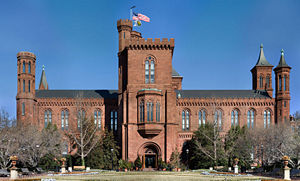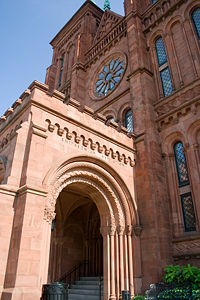Smithsonian Institution
The Smithsonian Institution (pronounced [smɪθ.ˈso.ni.ˌən]) is an educational and research institute and associated museum complex, administered and funded by the government of the United States and by funds from its endowment, contributions, and profits from its shops and its magazine. It also publishes a monthly magazine the Smithsonian and the Smithsonian Networks, a new multiplatform network that uses Smithsonian archives and resources to create original HD programming. Most of its facilities are located in Washington, D.C., but its 19 museums, zoo, and eight research centers include sites in New York City, Virginia, Panama, and elsewhere. It has over 142 million items in its collections.
History
The history of the Smithsonian Institution is as complex as the organization itself. In 1826, the British scientist James Smithson created his last will and testament in which he stated that should his nephew, Henry James Hungerford, die without heirs, the Smithson estate would go to the United States of America for creating an "Establishment for the increase & diffusion of Knowledge among men." The exact reason for this request is unknown for Smithson never visited America nor did he seem to have any ties to the country. Nonetheless, after his nephew died without heirs in 1835, President Andrew Jackson informed Congress of the bequest, which amounted to 104,960 gold sovereigns, or $500,000 U.S. dollars ($9,235,277 in 2005 U.S. dollars after inflation). Eight years later, Congress passed an act establishing the Smithsonian Institution, a hybrid public/private partnership, and the act was signed into law on August 10, 1846 by James Polk.[1]
Though the Smithsonian's first secretary, Joseph Henry, wanted the Institution to be a center for scientific research, before long it became the depository for various Washington and U.S. government collections. The voyage of the U.S. Navy circumnavigated the globe between 1838 and 1842. The United States Exploring Expedition amassed thousands of animal specimens, an herbarium of 50,000 examples, shells and minerals, tropical birds, jars of seawater and ethnographic specimens from the South Pacific. These specimens and artifacts became part of the Smithsonian collections, as did those collected by the military and civilian surveys in the American West, such as the Mexican Boundary Survey and Pacific Railroad Surveys, which assembled many Native American artifacts as well as natural history specimens. The Institution became a magnet for natural scientists from 1857 to 1866, who formed a group called the Megatherium Club.
The crenellated architecture of the Smithsonian Institution Building on the National Mall has made it known informally as "The Castle." It was built by architect James Renwick, Jr. and completed in 1855. Many of the other buildings are historical and architectural landmarks. Detroit philanthropist Charles Lang Freer's donation of his private collection for Freer Gallery, and funds to build the museum, was among the Smithsonian's first major donations from a private individual.
Mission
Organizational Structure
The Smithsonian Institution is established as a trust instrumentality by act of Congress, and it is functionally and legally a body of the federal government. More than two-thirds of the Smithsonian's workforce of some 6,300 persons are employees of the federal government. The Smithsonian is represented by attorneys from the United States Department of Justice in litigation, and money judgments against the Smithsonian are also paid out of the federal treasury.
The nominal head of the Institution is the Chancellor, an office which has always been held by the current Chief Justice of the United States. The affairs of the Smithsonian are conducted by its 17-member board of regents, eight members of which constitute a quorum for the conduct of business. Eight of the regents are United States officials: the Vice President (one of his few official legal duties) and the Chief Justice of the United States, three United States Senators appointed by the Vice President in his capacity as President of the Senate, and three Members of the U.S. House of Representatives appointed by the Speaker of the House. The remaining nine regents are "persons other than Members of Congress," who are appointed by joint resolution of Congress. Regents are allowed reimbursement for their expenses in connection with attendance at meetings, but their service as regents is uncompensated. The day-to-day operations of the Smithsonian are supervised by a salaried "Secretary" chosen by the board of regents.
Institutions
There are numerous institutions that are either a part of or associated with the Smithsonian Institution. Below is a list of the major individual institutions, along with a brief over view and web-links.
Washington, DC
- Anacostia Museum|Anacostia Museum and Center for African American History and Culture: Beginning as a museum on the local history of the Anacostia community, the museum now is dedicated to the history and culture of the African American experience. Features an on-line interactive educational database. [1]
- Arthur M. Sackler Gallery: Named after the medical doctor that donated his collection of art to Smithsonian upon his death, the museum houses a large collection of Asian artwork. [2]
- Arts and Industries Building: The original building of the National Museum, the building is currently closed as it undergoes renovations. [3]
- Freer Gallery of Art: Founded by Charles Lang Freer who donated his collection to the Smithsonian, the gallery exhibits the artwork of Asia and Asia Minor. [4]
- Hirshhorn Museum and Sculpture Garden: The Smithsonian's museum dedicated solely to contemporary and modern artwork. [5]
- National Air and Space Museum: Perhaps the most famous of all Smithsonian museums, the institution specializes in the history of aviation and space exploration, and houses such famous aircraft as The Spirit of St. Louis and Apollo landing capsules. [6]
- National Museum of African American History and Culture: This museum is currently being constructed, however when it is complete it will be solely dedicated to the complex experiences of African Americans since slavery. [7]
- National Museum of African Art: Art museum exhibiting the wide-ranging artwork of the African continent. [8]
- National Museum of American History: One of the largest of the Smithsonian Institution, the museum is dedicated to the history and many cultures of America from the Colonial period to the present. [9]
- National Museum of the American Indian: Dedicated to the preservation and presentation of the cultures of Native Americans. [10]
- National Museum of Natural History: Devoted to the natural history and evolution of the world. Special exhibits include the Hope Diamond. [11]
- National Portrait Gallery (United States)|National Portrait Gallery: Exhibits portraits by famous American artists, as well as portraits of famous Americans. Outside of the White House it is the only building to house a complete collection of Presidential Portraits. [12]
- National Postal Museum: Depicts the history of the Postal system in America. [13]
- S. Dillon Ripley Center: The center houses the International Gallery and Smithsonian Travel exhibits which continually change as well as the Smithsonian Associate center. [14]
- Smithsonian Museum of American Art: Exhibits artwork of America throughout the country's history. [15]
- Smithsonian Institution Building: Nicknamed "The Castle", it was the first building in the Smithsonian complex and now houses the Smithsonian adminstration offices and information center. [16]
- Smithsonian National Zoological Park (National Zoo): Commonly rated as one of the world's best zoos, the National Zoo exhibits over two-thousand animals and is one of the few zoos in North America to house giant pandas. It also runs various conservation projects around the world. [17]
New York, NY
- Cooper-Hewitt, National Design Museum: Only institution in America dedicated to the history of and contemporary progress in the field of designing. [18]
- The George Gustav Heye Center: Dedicated to the history and culture of Native Americans, featuring permanent and temporary collections. [19]
Chantilly, VA
- National Air and Space Museum's Steven F. Udvar-Hazy Center: The companion site to the National Air and Space Museum, the center is a large facility that exhibits aircraft not able to be shown in the Mall museum. [20]
Smithsonian research centers
The following is a list of Smithsonian research centers, with their affiliated museum in parentheses.
- Smithsonian Astrophysical Observatory and the associated Harvard-Smithsonian Center for Astrophysics
- Carrie Bow Marine Field Station (Natural History Museum)
- Center For Earth and Planetary Studies (Air and Space Museum)
- Conservation and Research Center (National Zoo)
- Smithsonian Environmental Research Center
- Marine Station at Fort Pierce (Natural History Museum)
- Migratory Bird Center (National Zoo)
- Museum Conservation Institute
- Smithsonian Tropical Research Institute
- Woodrow Wilson International Center for Scholars
- Smithsonian Institution Libraries
- Center for Folklife and Cultural Heritage
Criticism
The Smithsonian Institution has been criticised for strong copyright restrictions[2][3] imposed on its image collections which overwhelmingly consist of public domain content dating to the 19th century. An image without a Smithsonian watermark and at a resolution suitable for publication requires an expensive licensing fee, manual approval by the Smithsonian staff, and the restriction of any further use without permission. This conflicts with the institution's own policy in a 2005 memo, in which it asserted, "The Smithsonian cannot own copyright in works prepared by Smithsonian employees paid from federal funds",[4] as well as the institution's own charter by the U.S. Congress to "increase and diffuse knowledge."
The Smithsonian Institution has also been critcised by the ACLU for self-censorship of a climate change exhibit. The ACLU believes that Smithsonian scholars watered down a report about climate change to avoid upsetting the Congress and the Bush White House.[21]
Further reading
- Nina Burleigh, Stranger and the Statesman: James Smithson, John Quincy Adams, and the Making of America's Greatest Museum, The Smithsonian, HarperCollins, September 2003, hardcover, 288 pages, ISBN 0-06-000241-7
- Heather Ewing (2007). The Lost World of James Smithson: Science, Revolution, and the Birth of the Smithsonian. Bloomsbury. ISBN 9780747576532.
Notes
- ↑ (2007) The Smithsonian Institute ["The History of the Smithsonian"] Retrieved August 7, 2007
- ↑ Smithsonian Images-Copyright
- ↑ Use of Content from Smithsonian Website
- ↑ Smithsonian Institution-Office of General Counsel
ReferencesISBN links support NWE through referral fees
External links
- Smithsonian Institution webpage
- Smithsonian Education webpage
- The University of Wisconsin Digital Collections Center presents The Smithsonian Scientific Series, a publicly accessible digital resource intended to enlighten and interest the general reader. It does not represent an attempt to summarize all science, or even all branches of science on which the Smithsonian can speak with authority. It will, however, acquaint the reader with the organization, history, and activities of the scientific institution which has grown up with the nation and fostered the nation's scientific activities. It is an introduction to the workings and achievements of the scientific method over a large field, and may open doors to some branches of science.
- Smithsonian Networks webpage
- Smithsonian Student Travel, an educational travel partnership.
- The Yale Scientific Magazine's view on Smithsonian Institution's misrepresentation of the important historical facts
- Smithsonian Gem & Mineral Collection
Credits
New World Encyclopedia writers and editors rewrote and completed the Wikipedia article in accordance with New World Encyclopedia standards. This article abides by terms of the Creative Commons CC-by-sa 3.0 License (CC-by-sa), which may be used and disseminated with proper attribution. Credit is due under the terms of this license that can reference both the New World Encyclopedia contributors and the selfless volunteer contributors of the Wikimedia Foundation. To cite this article click here for a list of acceptable citing formats.The history of earlier contributions by wikipedians is accessible to researchers here:
The history of this article since it was imported to New World Encyclopedia:
Note: Some restrictions may apply to use of individual images which are separately licensed.


